HABEY BIS-6922 Fanless Ivy Bridge Industrial PC Review
by Ganesh T S on August 13, 2013 9:00 AM EST- Posted in
- Industrial PC
- Ivy Bridge
- Passive Cooling
- Habey
Power Consumption and Thermal Performance
The power consumption at the wall was measured with the display being driven through the HDMI port. In the graphs below, we compare the idle and load power of the BIS-6922 with other low power desktop / industrial PCs. For load power consumption, we ran Furmark 1.11.0 and Prime95 v27.9 together.
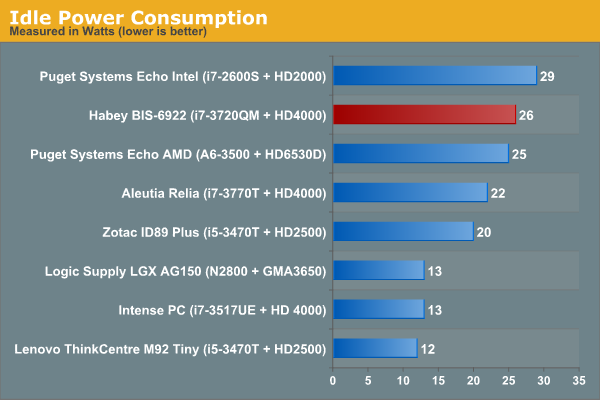
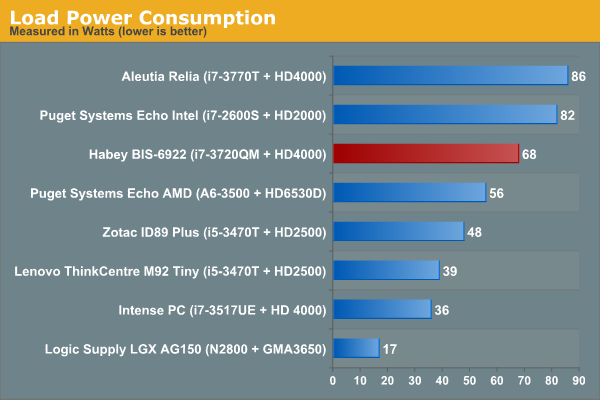
One of the unfortunate aspects of the Aleutia Relia was that the unit ended up getting throttled when subject to heavy loading even at room temperature (72 F). It is definitely challenging to cool 45W TDP processors in a mini-ITX sized chassis, and Aleutia had to get back to the drawing board after our findings were published. After that exercise, I was looking forward to evaluating other fanless PCs in order to gauge their thermal performance under heavy loading. Our custom fanless Ivy Bridge HTPC managed to do quite well, but it was in a ATX-sized chassis.
Habey is not new to the fanless game, and their experience shows in the choice of processor for the BIS-6922 review sample. While the i7-3770T used in the Aleutia Relia and the i7-3720QM used in the BIS-6922 both have a 45W TDP, we find that the former's TCASE is 70C (TJUNCTION around 75C) and the latter has a TJUNCTION of 105C. This gives the cooling system more leeway to operate without throttling the processor.
We conducted thermal testing by fully loading up both the CPU and the GPU for 18 hours. The room temperature varied between 74 F and 78 F during the duration of the test. Power consumption at the wall was recorded for the first 90 minutes or so (and we found that it settled down to around 67 W beyond that). Unlike the Aleutia Relia where thermal throttling was activated and resulted in power consumption at the wall going down after some time, we find that there is no thermal throttling at play in this system. The load and CPU frequencies were presented in the Relia review, but we won't present them here since the load stayed at 100% and the frequency of the cores was always at 2.594 GHz throughout the course of the stress test.
The average of the temperatures of the four cores of the CPU is presented in the graph above. The maximum junction temperature of the Core i7-3720QM is 105 C, and the BIS-6922 cooling mechanism was able to keep it under that without throttling the CPU. We find that it did touch 105 C once, but the temperature was gradually pulled down without throttling the clocks. On one hand, this makes us a bit worried about the possibility of throttling when the ambient temperature exceeds 80F or so. On the other hand, the above experiment was conducted with the unit placed on the floor in a closed room without any forced air flow. At higher surrounding temperatures, it is definitely advisable to ensure some sort of air flow over and around the unit to help with the cooling process. Habey indicated that the unit could be operated even with the ambient at 50 C, though we suppose they don't expect their customers to run artificial CPU and GPU loading programs to stress the system for days together.
Another interesting aspect is how fast the unit is able to get back to the idle temperature after removal of the processor load. The graph below shows that the unit gets back to the 45C (within 10C of the idling temperature) within 60 minutes.
We conclude this section with a thermal profile of the case after 18 hours of being subject to full CPU and GPU loading. Temperatures are noted in the format (F / C).


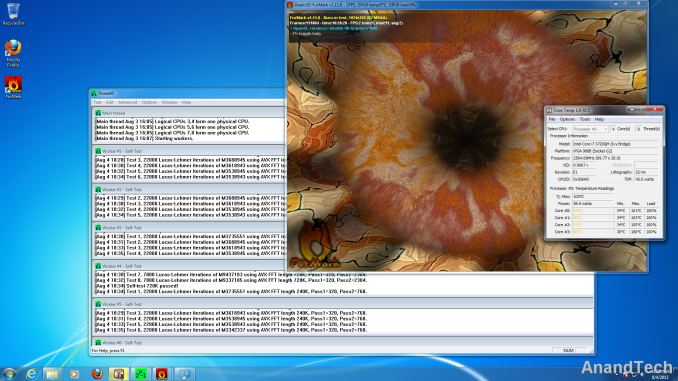
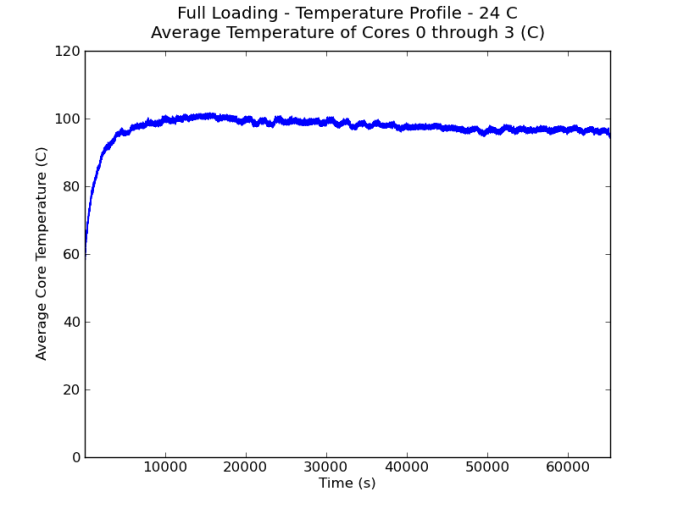
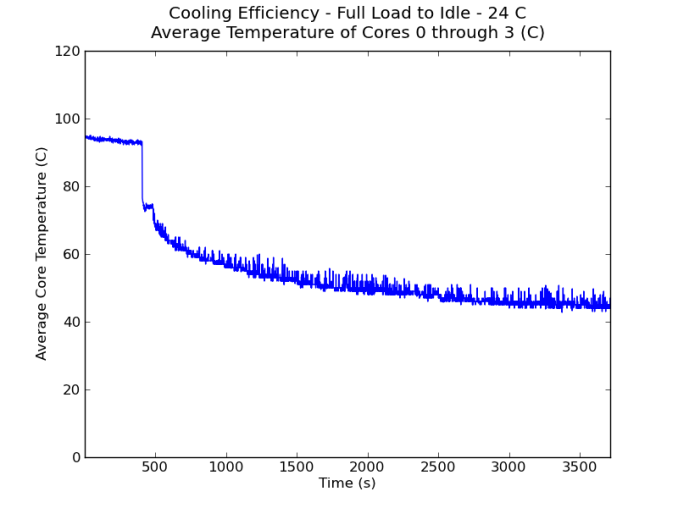
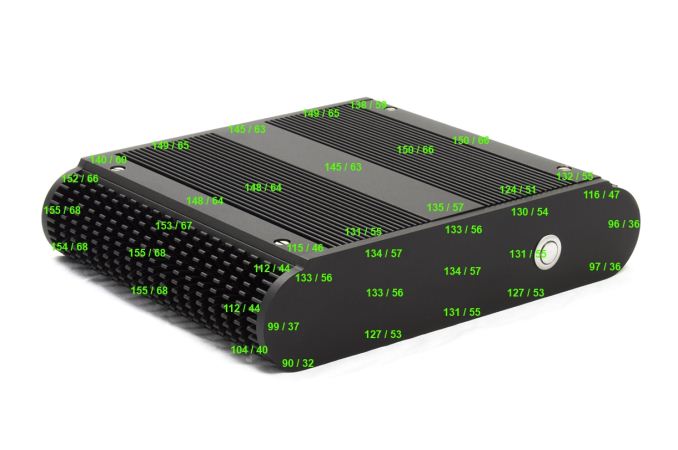
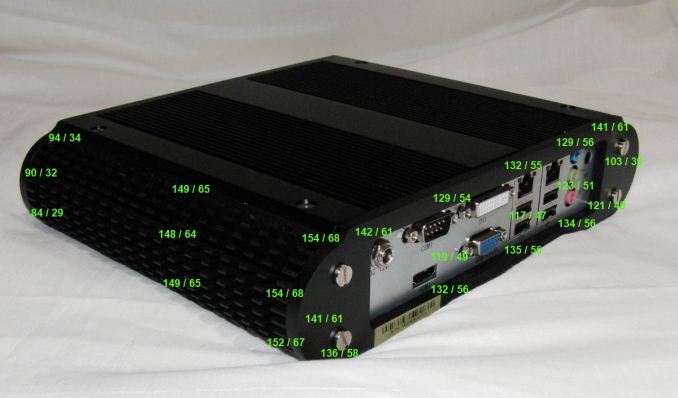








63 Comments
View All Comments
airmantharp - Tuesday, August 13, 2013 - link
It's too hot? Only if you lock it away. But since it's small and it produces no noise, you could place it somewhere it might get airflow, unlike a larger system.But why would a music or movie editor use one of these? How is that representative at all? GigE isn't fast enough for that, there is no TB port, so what, USB3? Really?
I think you're perspective on this system is poor- this system is designed to be used outside of the living room, which the Mac Pro is not; and the Mac Pro is huge in comparison!
UpSpin - Wednesday, August 14, 2013 - link
My current computer is a MiniITX placed on my desk next to my display. I would place the habey PC on the same place, and there's just no airflow, except I mount a fan on top of it. I also don't think that Ganesh placed this computer inside a small box but ran it on his main desk.What person needs a quad core high end system? How is GigE not fast enough? Why should USB3 (5Gbit/s) not be fast enough? And what has all of this to do with TB? And how are Windows people able to do music or video right now? They also don't have TB! And they also can't stuff all hard discs in their case, but need some larger and more secure storage server somewhere else.
Why do you compare the Mac Pro with this one? I only mentioned it because of its design. The design of this habey is just poor and fails to cool the system. A design similar to the Mac Pro which makes use of a chimney effect would have been much better.
So this system is to be used outside of the living room, but according to you also not suited for work because it lacks TB and we might tax it too much. So we could use it for terminals which need a quad core CPU (I don't know a single use case), but therefore it's also not suited because it will get too hot because there won't be any air flow either.
I don't get it, where can we use such a thing?
Dentons - Wednesday, August 14, 2013 - link
You're right. There is no use-case for this system as configured. None at all.Either you need an i7 or you don't. If you need an i7, this product can't cool it adequately, so is a terrible choice.
ganeshts - Wednesday, August 14, 2013 - link
I am pretty sure Habey's intent was to provide enough CPU grunt for occasional bursts and not 24x7 loading.I am still waiting for someone to link me to a similar product (size / CPU perf.) with better thermal performance.
Dentons - Wednesday, August 14, 2013 - link
There may not be any similar product able to handle the heat created by a fully utilized i7. That doesn't excuse this product's failings. What it actually suggests is that Habey reached too high.It shouldn't be surprising that a fully utilized i7 needs active cooling.
UpSpin - Thursday, August 15, 2013 - link
I completely disagree. It's a quad core! If Habey wanted to provide a CPU for occasional bursts used in industrial environments, they would have used a high end dual-core! If one program needs some more processing power it easily gets it. But barely any program scales dynamically across multiple cores, except high end software which won't get used in a terminal but in production environments. And then, this software really taxes the system. You also don't need a quad core for multi-tasking, except you really tax the system (maybe 3 cores) and still want to continue to work with the computer on the fourth core. But again, this Habey system won't support this without exceeding several temperature limits.And maybe there are no comparable systems, because such a small case with such a poor 08/15 design just can't dissipate the required heat without active cooling?
Dentons - Wednesday, August 14, 2013 - link
This is a machine designed to function without fans. If it requires air flow in order to work properly, the design is a failure. This case was probably designed to run with far cooler chips, but since that wasn't tested with those, we just don't know if it works adequately with them.Yes, a lot of video production is done on Mac's, but certainly not all. Probably not even half. Windows does still hold nearly 90% of the desktop / laptop market.
You fail to address the really important question. What is the point of an i7 if it's power can't actually be used? Transcode some video and the temperature of the case will exceed many safety standards and the internal components will be heated to well beyond their rated temps?
That's acceptable?
fluxtatic - Saturday, August 17, 2013 - link
The new Mac Pro isn't passive, and how the hell are industrial users going to use something that looks like a trashcan?The Mac Pro is a an honest-to-god workstation with a Xeon (well, it's got a Xeon, at least). This is like comparing Little League to MLB.
crashtech - Thursday, August 22, 2013 - link
It's Furmark. I wonder how hot the thing would get in any conceivable real-world app. Probably under half those temps. The takeaway is it passed a torture test.whyso - Tuesday, August 13, 2013 - link
Looks like its throttling. I have a 3630qm which gets about 6.3-6.4 in cinebench R11.5. This 3720QM is getting significantly lower than that.